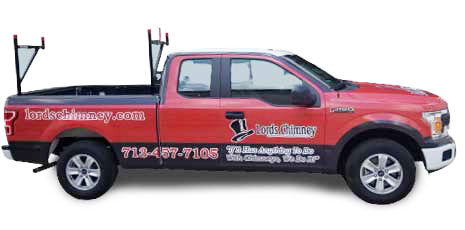For Chimney & Fireplace Repair Near You, Trust Lords Chimney in Kingwood & Surrounding Areas
We love serving locals in the Kingwood, TX, and we’re happy to offer the best chimney and fireplace repair services near you. If you’ve been on the hunt for a local chimney service provider, we’d love to help you out. Call or book online now.
Chimney & Fireplace Repair Near Me: Why Does My Chimney Smell?
As the warmer spring and summer months arrive, you might notice an unpleasant smell coming from your chimney.
This is often due to your air conditioner running, which creates negative pressure in the house. This negative pressure can pull air from your fireplace or chimney into the home, bringing with it that musty, sooty, or smoky odor with it.
What should I do if my chimney smells bad?
Whenever you notice this type of smell, it’s important to address it, as it typically signals an underlying issue. The chimney could be overly dirty, or there could be other factors contributing to the problem. To get to the root cause, it’s a good idea to book an inspection with a professional. Our team will assess the situation and determine whether the problem lies within the chimney itself or if an HVAC technician is needed to resolve any airflow issues.
Chimney Masonry Repair Near Me: Explain the Process of Tuckpointing My Chimney
Over time, the mortar joints between the bricks of your masonry chimney deteriorate due to exposure to weather, moisture, heat, and – sometimes – neglect. If left unaddressed, this can lead to water infiltration, brick damage, and even structural instability. Tuckpointing is a crucial masonry repair process that restores the structural integrity and appearance of your chimney’s mortar joint by removing the old mortar and replacing it with new mortar.
Here’s a step-by-step breakdown of the tuckpointing process for your chimney:
- Step 1 – Inspection and Assessment: A professional chimney technician will assess the condition of your chimney’s mortar joints to determine the extent of deterioration. Cracks, gaps, and missing mortar are key indicators that tuckpointing is needed.
- Step 2 – Removing Damaged Mortar: The damaged mortar is carefully removed using specialized tools such as a grinder or chisel. The depth of removal is typically about ½ inch to ¾ inch to ensure a proper bond with the new mortar.
- Step 3 – Mixing New Mortar: A mortar mix that closely matches the original in color, composition, and texture is prepared. Matching the mortar ensures a seamless repair and maintains the historical and structural integrity of the chimney.
- Step 4 – Applying New Mortar: The new mortar is carefully packed into the cleaned joints using a trowel or pointing tool. It’s shaped and smoothed to create a uniform appearance. This step restores both strength and weather resistance to the chimney.
- Step 5 – Finishing and Curing: Once the mortar begins to set, excess material is brushed away for a clean finish. The mortar is left to cure properly, which can take several days.
To extend the lifespan of the repair, a breathable masonry waterproofing sealant can be applied. This helps protect the chimney from future moisture damage while allowing trapped moisture to escape.
Tuckpointing not only enhances the appearance of your chimney, but also prevents costly structural damage. If you notice crumbling mortar or loose bricks, it’s best to contact a professional masonry contractor to assess your chimney and recommend the necessary repairs.
Can I DIY Tuckpointing & Masonry Repair, or Should I Trust a Professional?
While some home improvement projects are great for DIYers, tuckpointing and masonry repair – especially for a chimney that vents heat and smoke – are best left to professionals. Here’s why trusting a pro is the right choice:
- They use the proper tools and materials. Tuckpointing requires specialized tools, and the mortar mix needs to match the existing chimney in order for a polished result and structural stability.
- They know how to work with chimneys. Your chimney isn’t just a decorative funnel – it plays a crucial role in venting smoke and gases safely. Poorly executed tuckpointing can lead to weak mortar joints, allowing moisture to seep in, which accelerates brick deterioration and structural instability.
- They take proper safety precautions. Chimney repairs often require working at heights and handling heavy materials. Without proper safety training and equipment, a DIY attempt could result in injury or further damage to your chimney.
- Matching mortar is a complex process. Using the wrong mortar mix can cause more harm than good. Older chimneys often require specific lime-based mortar, while modern structures use Portland cement-based mixes. Mismatched mortar can lead to premature cracking and damage – and, of course, unsightly results.
- Professionals ensure long-term cost savings. Wile DIY tuckpointing might seem like a way to save money, mistakes can lead to more expensive repairs in the long run.
- Professional can identify other issues. A trained chimney expert can spot other underlying problems – such as spalling bricks, water damage, or chimney crown deterioration. Addressing these issues early prevents costly future repairs.

In the end, while DIY can be tempting, chimney tuckpointing and masonry repair requires precision, experience, and specialized tools. Hiring a professional ensures your chimney remains safer, more structurally sound, and visually appealing for years to come.
For Chimney & Fireplace Repair Services Near Your Kingwood Home, Lords Chimney Can Help
When it comes to chimney and fireplace repair services near you in Kingwood, trust the experts at Lords Chimney – every time. Our team is dedicated to ensuring your fireplace operates as safely and efficiently as possible with every season, giving you peace of mind all year round. Whether you need repairs, inspections, or maintenance, we’re here to help.
Contact us today to schedule your service.

